Yes, I am a bit obsessed with Marmalade right now. See?
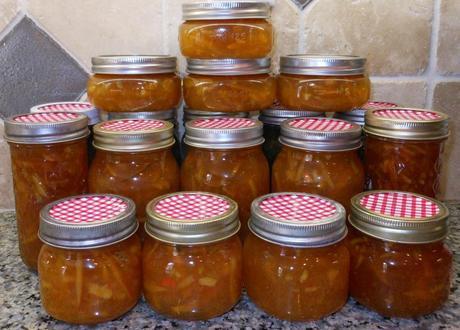
18 jars of marmalade! Recipe and photo step-by-step found here.
Do I need my family to stage an intervention? Maybe. Maybe not, because I am willing to share. :) I was able to make all this marmalade at one time, because my son arrived home for the summer (from college). He kindly agreed to help me cut up the oranges and tended to the second pot of marmalade, so I could make twice as much at once. I could not have done it without him. Thanks, David!
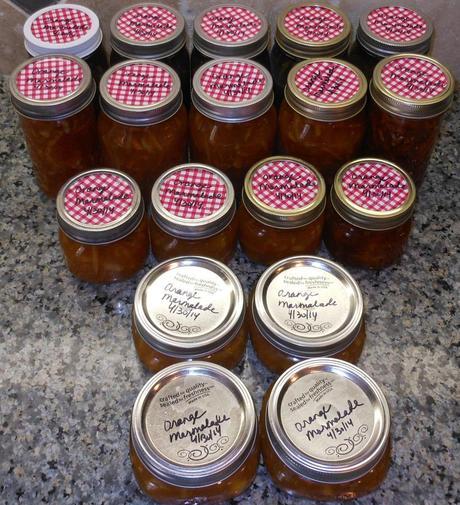
Look at all those jars of yummy, marmalade goodness!
Have you ever considered canning food at home? Maybe some tomatoes, peaches, or your own jams and jellies? It’s a bit scary, isn’t it? There are so many horror stories: jars exploding, canners exploding, botulism, and spoiled food. Wouldn’t it just be easier to buy food from the store?
Well, yes, it is easier to buy food from the store. If that makes you happy, and you like it, I’m not going to dissuade you from doing it. BUT… Home canned food, when done with care and attention and with a tested recipe, is delicious and cost effective, plus you know EXACTLY what is in your food. There are so many wonderful resources available to make it easy. I’m going to give you a few tips that helped me be successful when I started canning my own food. I’ve posted some of these before, but they bear repeating.
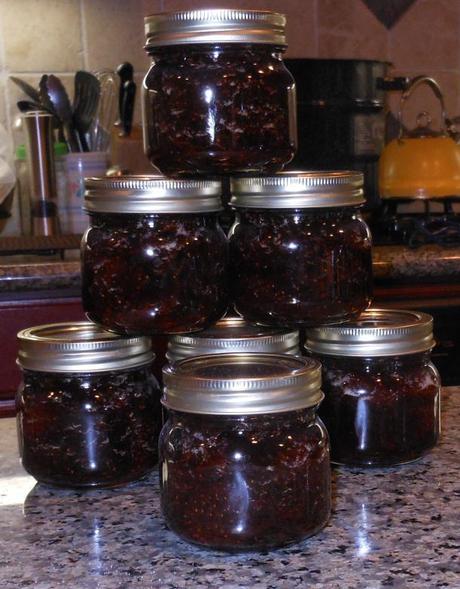
Lovely Strawberry Preserves. See how to make them here.
Important Canning Basics
1. Cleanliness is next to Godliness – It is imperative that you follow these basic instructions to keep your canned food free from harmful bacteria.
- Wash your hands with soap under warm water before you begin.
- Wash and sterilize your canning jars. If your dishwasher has a sterilize setting, that will work just fine. If not, you can wash your jars in hot, soapy water and rinse. Then, put the jars into a pot of hot water, making sure the jars are covered with water, and bring to a rolling boil. Boil for at least 10 minutes to sterilize your jars.
- Wash the seals and rings in warm, soapy water.
- Use new seals every time you can!
- Use a clean knife, cutting board, and other tools.
- Make sure you process the jars the correct amount of time. I live at an elevation of 1200 feet above sea level, so I need to add additional time when I process my jars. Don’t know your elevation? Check out this website to determine your elevation. Then visit this website for the National Center for Home Food Preservation to determine how to adjust your processing time.
2. Choose the correct canning method – There are two recommended methods for canning: water bath and pressure canning. Some foods must be processed with a pressure canner. Please consult a canning book or a reputable canning website (like the one at USU, found here) to determine if the food you wish to can requires pressure canning.
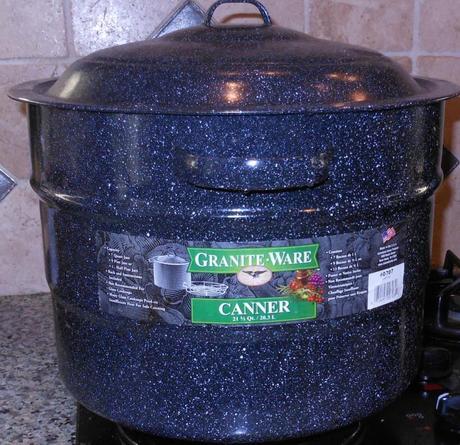
This is my water bath canner. While you do not have to use a pot designated as a “canning” pot, they’re not too expensive, and they come with a rack. In fact, as of today’s posting, this pot is on sale on Amazon for $19.97, and it ships for free with Amazon prime. To see it, click here. Or, check your local Walmart or grocery store. They’re likely to carry this pot as well. I paid $20 for mine at my local Wal-mart a few years ago.
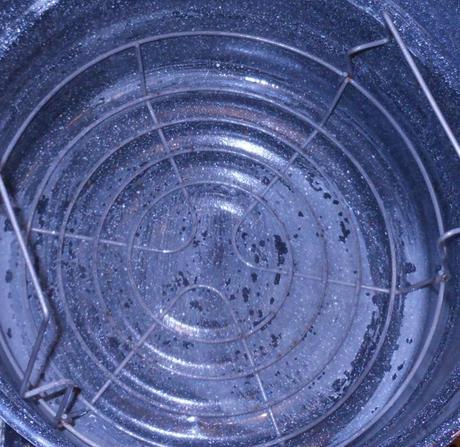
This is the rack inside my canner. (Yes, I should probably clean off those hard water stains. I know. I’ll get to it.)
- The “water bath” method is what it sounds like. You put your jars in a pot full of hot water (taking care to use a rack so the jars do not directly touch the bottom of the pan) and boiling the jars for the specified amount of time. Water bath canning is used for high acid foods which includes most fruits, jams, and jellies.
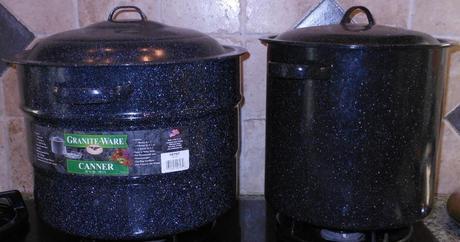
When I have a lot to can, I use a stock pot as well. I have a little rack that fits in the bottom to keep the jars from touching the bottom of the pan. Seriously, any pot will work if you have a rack (to keep the jars off the bottom of the pan), and it’s deep enough that the water level is at least 2 inches above the top of the jars.
- Pressure canning uses a specially designed pressure canner and is used for low acid foods such as meats, certain vegetables, and beans. The pressure canner brings the temperature inside the canner goes up to 240 degrees which will kill botulism (which thrives in low acid environments unless killed with high temperatures). Ingesting food contaminated with botulism can be fatal.

This is my pressure canner. It’s about as wide as my water bath canner, but it’s a bit taller. I bought mine through Amazon. You can see it here. I have canned chicken (see post here), pinto beans (see post here), and ground beef (see post here), and it’s done a fabulous job!
3. Use only reputable websites and books as references when you can food at home – Anyone can operate a website or blog (just look at me). You have no way of knowing if the recipes they post have been safety tested. When you preserve food at home, it is extremely important that the recipes you use have been safety tested. The good news is that there are many wonderful websites from reputable organizations which can help you immensely when canning food at home. The organizations that operate these websites have safety tested the recipes and instructions included, so you know you will be safe and enjoy good results for your efforts. Here are a few of my favorite resources.
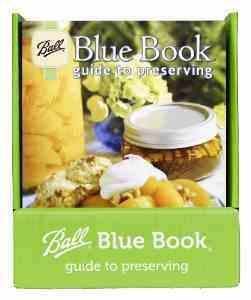
Ball Blue Book. Photo courtesy of Amazon.com
- Ball’s Blue Book: Guide to Preserving – I use this book for most of my canning. My carrot cake jam was made from the recipe in this book.
- USU’s link to the USDA Canning Guide
- USU’s Food Preservation and Canning website
- Ball’s Canning website – includes recipes and instructions.
- National Center for Home Food Preservation – Includes canning instructions as well as information on dehydrating, freezing, pickling, curing, and fermenting your own foods.
4. Be Prepared – Have your equipment washed, ready to use, and nearby before you begin canning. For example, do not try to wash and sterilize your jars while you are stirring marmalade on the stove. You may be able to do it, but you may not have enough time to sterilize the jars before the the marmalade is ready which can cause all sorts of problems.
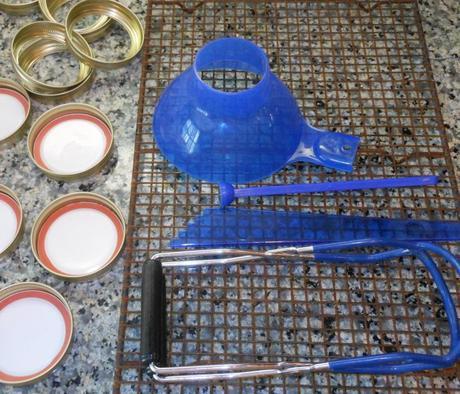
Make sure your “tools” are ready.
Truth be told, if you can follow instructions, and you make sure your instructions are from a reputable source (see some listed above), you, too, can have lovely jars of food you make at home. You will save money, and you will have delicious food made to your tastes! Who knows? Maybe you will become marmalade obsessed, just like I am!
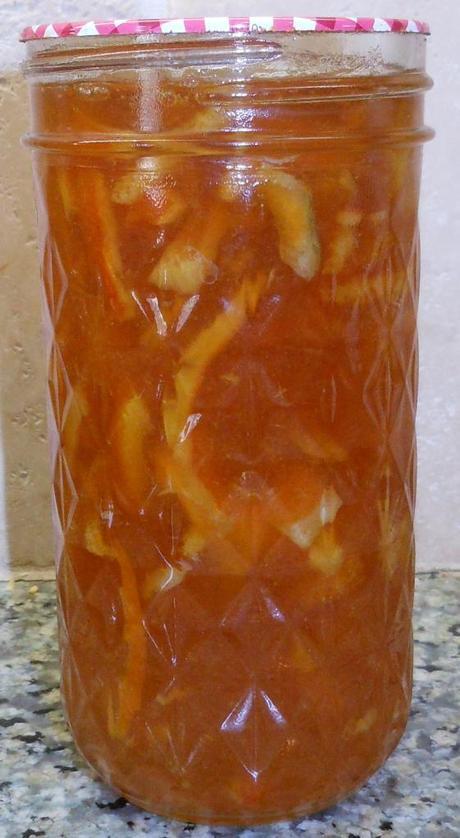
Another jar of delicious orange marmalade!
So, did I convince you to try canning food at home?
If not, what’s stopping you?
* * * This post contains affiliate links. To learn more about affiliate links, please visit my about page. * * *
